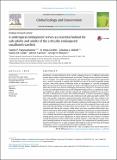Files in this item
A subtropical embayment serves as essential habitat for sub-adults and adults of the critically endangered smalltooth sawfish
Item metadata
| dc.contributor.author | Papastamatiou, Y.P. | |
| dc.contributor.author | Dean Grubbs, R. | |
| dc.contributor.author | Imhoff, J.L. | |
| dc.contributor.author | Gulak, S.J.B. | |
| dc.contributor.author | Carlson, J.K. | |
| dc.contributor.author | Burgess, G.H. | |
| dc.date.accessioned | 2015-05-25T13:10:04Z | |
| dc.date.available | 2015-05-25T13:10:04Z | |
| dc.date.issued | 2015-01 | |
| dc.identifier | 190315116 | |
| dc.identifier | 4d9320b3-a854-49eb-9506-470b3495540d | |
| dc.identifier | 84928137451 | |
| dc.identifier | 000416220000064 | |
| dc.identifier.citation | Papastamatiou , Y P , Dean Grubbs , R , Imhoff , J L , Gulak , S J B , Carlson , J K & Burgess , G H 2015 , ' A subtropical embayment serves as essential habitat for sub-adults and adults of the critically endangered smalltooth sawfish ' , Global Ecology and Conservation , vol. 3 , pp. 764-775 . https://doi.org/10.1016/j.gecco.2015.03.003 | en |
| dc.identifier.issn | 2351-9894 | |
| dc.identifier.uri | https://hdl.handle.net/10023/6687 | |
| dc.description | Date of Acceptance: 06/03/2015 | en |
| dc.description.abstract | Identifying essential habitat for large, mobile endangered species is difficult, particularly marine species where visual observations are limited. Though various methods of telemetry are available, each suffers from limitations and only provides satisfactory information over a specific temporal or spatial scale. Sawfish are one of the most imperilled groups of fishes, with every species worldwide listed as endangered or critically endangered. Whereas movements of juvenile sawfish are fairly well studied, much less is known about adults due to their rarity and the challenging environments they live in. Previous encounter records have identified Florida Bay in the Everglades National Park as a potentially important habitat for adults of the critically endangered smalltooth sawfish (Pristis pectinata). We used a combination of acoustic and satellite telemetry, as well as conventional tagging, to determine patterns of movement and residency by sub-adult and adult sawfish. Over short time periods, movements appeared primarily tidal driven with some evidence that animals moved into shallow water during the ebbing or flooding tides. Adult sawfish sexually segregated seasonally with males found by mangrove-lined canals in the spring and females predominantly found in outer parts of the bay. Males migrated from canals starting in late May potentially as temperatures increased above 30°C. Some males and females migrated north during the summer, while others may have remained within deeper portions of Florida Bay. Male sawfish displayed site fidelity to Florida Bay as some individuals were recaptured 1-2 years after originally being tagged. We hypothesize that mating occurs in Florida Bay based on aggregations of mature animals coinciding with the proposed mating period, initial sexual segregation of adults followed by some evidence of females moving through areas where males show seasonal residency, and a high percentage of animals showing evidence of rostrum inflicted injuries. The combination of methods providing movement data over a range of spatial and temporal scales reveals that sub-tropical embayments serve as essential habitat for adult smalltooth sawfish. | |
| dc.format.extent | 12 | |
| dc.format.extent | 2184610 | |
| dc.language.iso | eng | |
| dc.relation.ispartof | Global Ecology and Conservation | en |
| dc.subject | Telemetry | en |
| dc.subject | Mating | en |
| dc.subject | Sawfish | en |
| dc.subject | Conservation | en |
| dc.subject | Florida Bay | en |
| dc.subject | QH301 Biology | en |
| dc.subject | QL Zoology | en |
| dc.subject | SDG 14 - Life Below Water | en |
| dc.subject.lcc | QH301 | en |
| dc.subject.lcc | QL | en |
| dc.title | A subtropical embayment serves as essential habitat for sub-adults and adults of the critically endangered smalltooth sawfish | en |
| dc.type | Journal article | en |
| dc.contributor.institution | University of St Andrews. School of Biology | en |
| dc.identifier.doi | 10.1016/j.gecco.2015.03.003 | |
| dc.description.status | Peer reviewed | en |
| dc.identifier.url | http://www.sciencedirect.com/science/article/pii/S2351989415000293#appd002 | en |
This item appears in the following Collection(s)
Items in the St Andrews Research Repository are protected by copyright, with all rights reserved, unless otherwise indicated.

